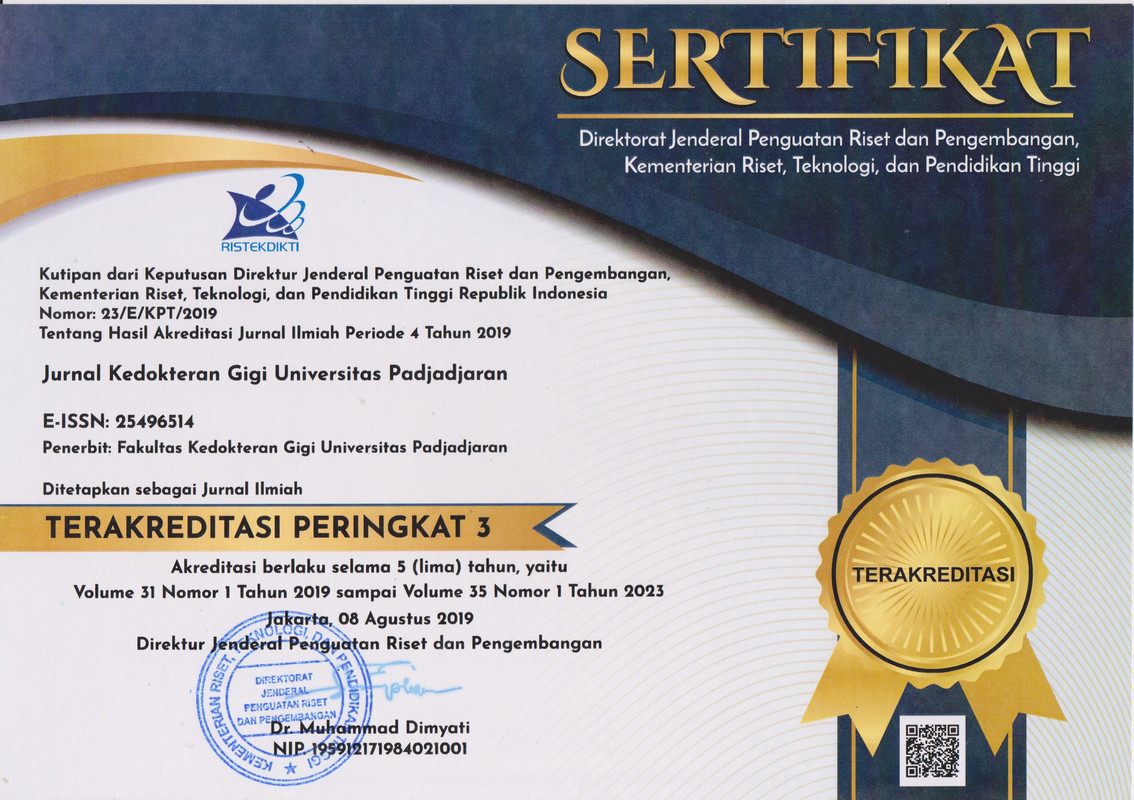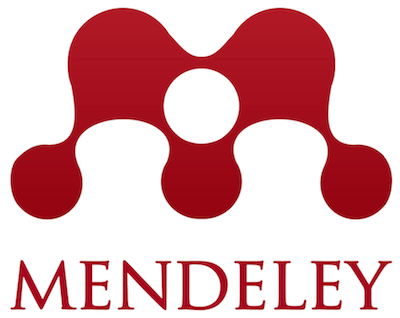Hubungan bentuk lengkung gigi dan gejala gangguan sendi rahang
Relationship between dental arch form and temporomandibular joint disorders symptoms
Abstract
Pendahuluan: Maloklusi dan gangguan sendi rahang merupakan kelainan pada rongga mulut bersifat multifaktorial dan telah dilaporkan memiliki keterkaitan. Maloklusi terjadi karena ketidaksesuaian panjang lengkung rahang dan panjang lengkung gigi. Maloklusi merupakan salah satu penyebab timbulnya gangguan pada sendi rahang (TMD) dengan gejala dan/atau tanda klinis yang bervariasi. Tujuan penelitian menganalisis hubungan antara bentuk lengkung gigi dan gejala TMD pada mahasiswa Fakultas Kedokteran Gigi Universitas Sumatera Utara. Metode: Jenis penelitian cross sectional menggunakan kuesioner dan model studi. Pengambilan sampel secara purposive sampling berasal dari prosedur pencetakan gigi berdasarkan kriteria inklusi yang meliputi karakteristik berikut: Mahasiswa Fakultas Kedokteran Gigi Universitas Sumatera Utara, usia 17-25 tahun dengan gigi permanen lengkap sampai molar kedua dan belum pernah mendapat perawatan ortodonti. Hasil: Hasil uji Chi-square dari 17 model gigi subjek perempuan dan 13 subjek laki-laki menunjukkan tidak ada hubungan yang bermakna antara lengkung gigi atas (p=0,953) dan bawah (p=0,828) pada subjek penelitian dengan TMD. Simpulan: Gejala TMD tidak berkaitan dengan variasi bentuk lengkung gigi pada subjek dengan gigi geligi lengkap. Namun, penelitian lebih lanjut perlu dilakukan dengan mempertimbangkan pemeriksaan tanda klinis gangguan sendi rahang, karakteristik maloklusi, serta adanya kebiasaan buruk.
Kata kunci: bentuk lengkung gigi; gejala; gangguan sendi rahang
ABSTRACT
Introduction: Malocclusion and temporomandibular joint disorders are multifactorial disorders of the oral cavity and have been reported to have an association. Malocclusion occurs because of the disharmony of the length of the jaw arch and the dental arch. Malocclusion is one of the causes of temporomandibular joint disorders (TMD) with various clinical symptoms and signs. The purpose of the study was to analyse the relationship between dental arch form and temporomandibular joint disorders symptoms in undergraduate students of the Faculty of Dentistry Universitas Sumatera Utara. Methods: This type of research was cross-sectional using a questionnaire and a study model. Purposive sampling was taken from the dental impression procedure based on the inclusion criteria, including the following characteristics: undergraduate students of the Faculty of Dentistry Universitas Sumatera Utara; aged 17-25 years with complete permanent teeth up to the second molar; had never received orthodontic treatment. Results: The chi-square test results of 17 female and 13 male subjects showed no significant relationship between the upper (p=0.953) and lower (p=0.828) dental arches in the study subjects with TMD. Conclusions: TMD symptoms were not associated with variations in the dental arch form in subjects with complete dentition. However, further research needs to be done by considering the examination of clinical signs of jaw joint disorders, characteristics of malocclusion, and the presence of bad habits.
Keywords: dental arch form; symptom; temporomandibular joint disorders
Keywords
Full Text:
PDFReferences
Dzingutė A, Pileičikienė G, Baltrušaitytė A, Skirbutis G. Evaluation of the relationship between the occlusion parameters and symptoms of the temporomandibular joint disorder. Acta medica Litu. 2017;24(3):167–75.
Mélou C, Leroux L, Meary F, Bertaud V, Padellec C Le, Lemaire A, et al. Relationship between Occlusal Factors, Oral Parafunctions and Temporomandibular Disorders: A Case Control Study. Int J Dent Oral Heal. 2019;5(4):1–5.
Khatri JM, Madaan JB. Evaluation of Arch Form among Patients Seeking Orthodontic Treatment. J Indian Orthod Soc. 2012;46(4):325–8.
Reissmann DR, Anderson GC, Haydecke G, Schiffman EL. Effect of Shortened Dental Arch on Temporomandibular Joint Intra-articular Disorders. J Oral Facial Pain Headache. 2018;32(3):329.
Miyake H, Ryu T, Himuro T. Effects on the dental arch form using a preadjusted appliance with premolar extraction in class I crowding. Angle Orthod. 2008;78(6):1043–9.
Oktarina IN, Zenab Y, Sunaryo IR. Tipe wajah dan bentuk lengkung gigi pada mahasiswa Fakultas Kedokteran Gigi angkatan 2010-2013 Universitas Padjadjaran. J Ked Gi Unpad. 2016;28(3):138–43.
Cruz CL, Lee KC, Park JH, Zavras AI. Malocclusion Characteristics as Risk Factors for Temporomandibular Disorders: Lessons Learned from a Meta-Analysis. J Oral Dis. 2015;2015:1–11.
Proffit W, Fields H, Larson B, Sarver D. Orthodontic Diagnosis: The Problem-Oriented Approach. In: Contemporary orthodontics. 2018. p. 2–175.
Himawan LS, Kusdhany LS, Ariani N. Temporomandibular disorders in elderly patients. Med J Indones. 2007;16(4):237–9.
Prahastuti N. Perubahan Tipe Bentuk Lengkung Gigi Paska Perawatan Ortodontik Cekat dengan Pencabutan Premolar Pertama ( Laporan kasus ) Change in The Form Type of Dental Arch Post The Fixed Orthodontic Treatment with Extraction of First Premolars ( Case report ). 2016;5(1):16–23.
Khoo JK, Bergman T, Avi L, N FR. Evaluation of Changes in TMJ Position for Angle Class I Malocclusion After Orthodontic Treatment by Using Cephalometric Radiograph. UI Proc Heal Med. 2016;1(1):58–62.
Saputra YG, Anindhita PS, Pangemanan DH. Ukuran dan bentuk lengkung gigi rahang bawah pada orang Papua. J e-GiGi. 2016;4(2):253–8.
Tanti I, Himawan LS, Kusdhany L, Bachtiar A, Ismail RI. Validation of stress screening questionnaire in temporomandibular disorders patient. J Int Dent Med Res. 2016;9(Specialissue):272–6.
Gumay RA, Tanti I, Koesmaningati H. The relationship between temporomandibular disorders and quality-of-life-related orofacial pain. J Int Dent Med Res. 2017;10(Specialissue):677–82.
Mohlin B, Axelsson S, Paulin G, Pietilä T, Bondemark L, Brattström V, et al. TMD in relation to malocclusion and orthodontic treatment: A systematic review. Angle Orthod. 2007;77(3):542–8.
Caldas W, Conti AC de CF, Janson G, Conti PCR. Occlusal changes secondary to temporomandibular joint conditions: A critical review and implications for clinical practice. J Appl Oral Sci. 2016;24(4):411–9.
Wijaya Y, Himawan LS, Odang RW. Occlusal Grinding Pattern during Sleep Bruxism and Temporomandibular Disorder. J Dent Indones. 2013;20(2):25–31.
Aboalnaga A, Amer N, Elnahas M, Fayed M, Soliman S, ElDakroury A, et al. Malocclusion and Temporomandibular Disorders: Verification of the Controversy. J Oral Facial Pain Headache. 2019;39(4):440–50.
DOI: https://doi.org/10.24198/jkg.v34i1.35002
Refbacks
- There are currently no refbacks.
Copyright (c) 2022 Jurnal Kedokteran Gigi Universitas Padjadjaran
INDEXING & PARTNERSHIP

Jurnal Kedokteran Gigi Universitas Padjadjaran dilisensikan di bawah Creative Commons Attribution 4.0 International License






.png)

















